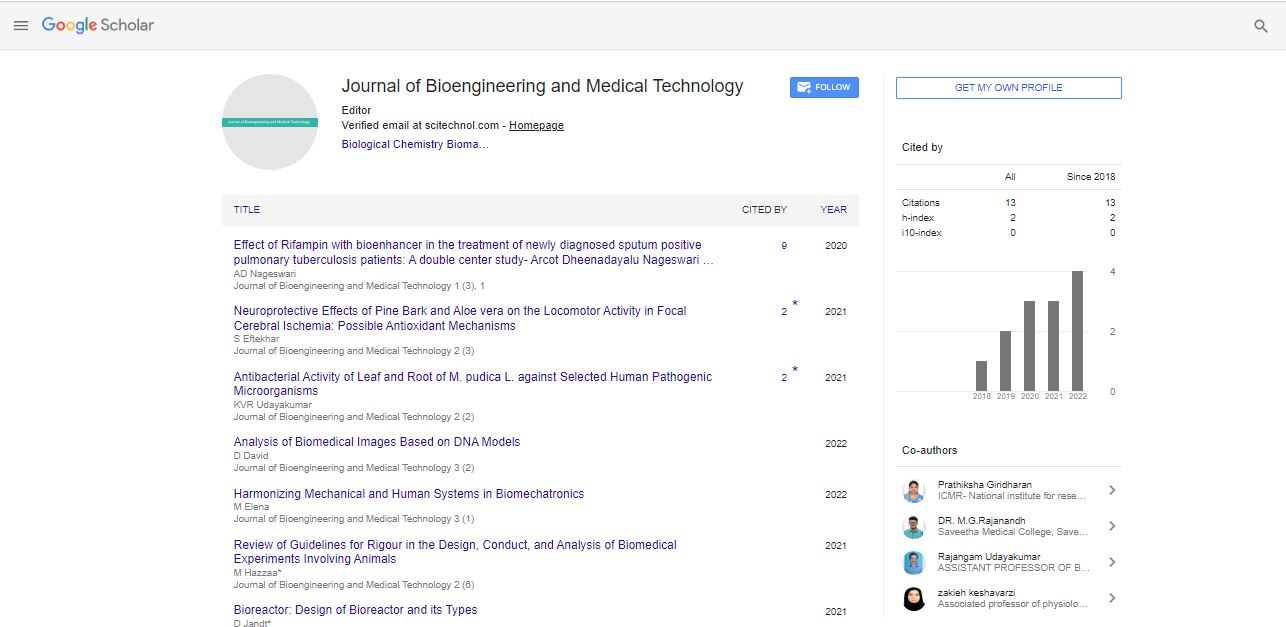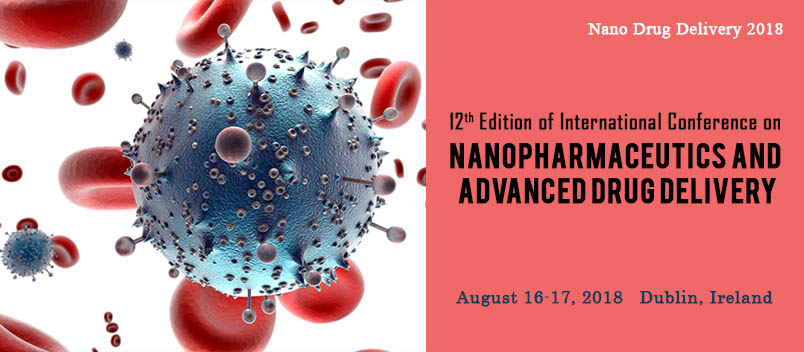About the Journal of Bioengineering and Medical Technology
Journal of Bioengineering and Medical Technology is an open access Journal providing a platform to multifaceted work in field of Bioengineering and Medical Devices that feature high quality research from authors across nations to explore the research developments in the field of Biomedical Engineering and Medical Technology.
Interested authors can submit manuscript via or Online Submission System or send us through email attached to the bioengineering@eventqueries.com
The Journal incorporates scientific knowledge to promote and discuss various innovative work in Bioengineering and Medical field for rapid publication of critical research, scientific papers and technical notes in form of Research article, Review articles, Mini reviews, Case reports, Opinion article, Short communications, Letter to the Editor, etc. The Journal's field of research encompasses studies on Bioinstrumentation, Computational sciences, Biomaterials, Nanomaterials, Biomechanics, Blood chemistry, Genetic engineering, Medical electronics, Clinical engineering, Medical imaging, Orthopedic surgery, Rehabilitation engineering, Biophotonics, Lab-on-a-chip techniques.
- Biological Chemistry
- Biomaterial Science
- Clinical Engineering
- Diagnostic Radiology
- Biomedical Analysis
- Medical Biomaterials
- Regeneration
- Medical Equipment
- Biomedical Information
- Computational Proteomics
- Biotechnology
- Biomedical Engineering
- Biomechanics
- Environmental Engineers
- Molecular Engineering
- Nanoscale Engineering
- Tissue Culture engineering
All manuscripts undergo a vigorous peer review process to ensure quality and originality. Approval by at least two independent reviewers and the editor is a pre-requisite for acceptance of a manuscript for publication.
Biological chemistry
Biological chemistry, also known as Biochemistry, is the study of chemical processes in the cells of living organisms. This includes the information flow through biochemical signalling between the cells, the flow of chemical energy through metabolism, etc.
Biomaterial Science
Biomaterial is a substance that has been engineered to interact with biological systems for medical, therapeutic or for diagnostic purposes. Biomaterials are derived from nature or synthesized in the laboratory using a variety of substances such as metallic components, polymers, composite materials or ceramics.
Clinical Engineering
Clinical engineering is one of the branch of Biomedical engineering which deals with the actual implementation of medical equipment and technologies used in hospitals or other clinical settings. Clinical engineering is used for applying and implementing medical technology to optimize healthcare delivery and it supports a broad range of healthcare activities.
Diagnostic Radiology
Diagnostic Radiology is a subject or specialty that uses medical imaging to diagnose and treat diseases within the body. A variety of imaging techniques such as X-ray radiography, Ultrasound, Computed Tomography (CT), Nuclear medicine including Positron Emission Tomography (PET) and Magnetic Resonance Imaging (MRI) are used to diagnose and/or treat diseases. The exams often use radiation, at levels that have been determined to be safe, to create detailed anatomical images.
Biomedical Analysis
Biomedical Analysis are the set of techniques that allow us to know, qualitatively and quantitatively, the composition of any material and chemical state. Analytical methods include Spectroscopy, Infrared spectroscopy, Raman spectroscopy, Chromatography, Gas chromatography, Surface analysis and various other techniques.
Medical Biomaterials
Biomaterials are biocompatible, non-immunogenic and non-teratogenic synthetic substance with adequate physical and mechanical properties used widely in medical applications. The study of biomaterials is called Biomaterials science or Biomaterials engineering. Biomaterials & Medical Applications mainly focuses on all the key areas of Biomaterials Engineering related to clinical practice and medical technologies.
Regeneration
Regenerative medicine restores the structure and functionality of the damaged tissues and organs. It works on the regeneration of body parts and organs from a person’s own cells and tissues. This eliminates the tissue rejection concept. It covers cell based regenerative therapies, stem cell transplantation, fetal stem cells, cancer stem cells, bone marrow stem cells, etc.
Medical Equipment
Medical equipment is designed to aid in the diagnosis, monitoring or treatment of medical conditions which includes several types, such as, Diagnostic equipment including Medical imaging machines, used to aid in diagnosis. Examples are Ultrasound and MRI machines, PET, CT scanners and X-ray machines.
Computational Proteomics
Computational Proteomics is the study of protein sequences using specialized software for the analysis of intact proteins and peptides. Proteomics is defined as the protein complement of the genome and involves the analysis of all the proteins in a given sample.
Biotechnologist
Biotechnology is the use of living systems and organisms to develop products, or any technological application that uses biological systems, living organisms, or derivatives, to make or modify products or processes for specific use. Depending on the tools and applications, it is often related with the fields of Bioengineering, Biomedical engineering, Bio manufacturing, Molecular engineering etc.
Biomedical Engineering
Biomedical engineering (BME) is the application of engineering principles and design concepts to medicine and biology and for healthcare purposes (e.g. diagnostic or therapeutic). Biomedical engineering mainly focuses on the studies that improve human health and health care at all levels of the studies.
Biomechanics
Biomechanics is closely related to engineering subject, because it is often used as traditional engineering sciences to analyse human biological systems. With the help of Biomechanics we can easily study the structure and functions of biological systems such as humans, animals, plants, organs, fungi, and cells by means of the methods of mechanics.
Environmental engineers
Environmental engineering is the branch of applied science and technology which deals with the application of scientific and engineering principles for the preservation of human populations from the effect of unfavourable environmental factors; Defence of environments in both local and global, from the potentially deleterious effects of natural and human activities; and enhancement of environmental quality. The environmental engineering agenda is offered in the Department of Civil engineering or Chemical engineering at engineering faculties. Environmental "civil" engineers focus on Hydrology, Bioremediation, Water treatment plant design and Water resources management.
Molecular Engineering
Molecular engineering is the most interdisciplinary by nature. It is a field of study concerned with the design and testing of molecular belongings deportment and interactions, in order to assemble advance systems, materials and action for individual functions. Encompassing particularly Bioengineering, Chemical engineering, Electrical engineering, Materials science, Mechanical engineering, Physics and Chemistry. Based on molecular principles, a rational engineering methodology is a contrast to the universal.
Nanoscale Engineering
Nano scale engineering is a branch of Bioengineering. It is also called Nanotechnology. Nanotechnology includes the science fields of Organic chemistry, Molecular biology, Micro fabrication, Surface science and Molecular engineering. Nano scale is a manipulation of molecules and atomics. Scientists current discourse is the future association of new applications of Nanotechnology, such as Biometrics, Nano medicines and Nanoelectronics.
Tissue Culture Engineering
Tissue culture Engineering is the combination of cells, materials, biochemical and physicochemical factors to replace biological tissues. Tissue Engineering is also called as Regenerative medicine. Tissue engineering covers a broad range of applications, in practice, the term is closely associated with applications that repair or replace portions of or whole tissues such as blood vessels, skin, muscles, bladder etc. Regenerative medicine is the use of stem cells or progenitor cells to produce tissues.
Fast Editorial Execution and Review Process (FEE-Review Process):
Journal of Bioengineering and Medical Technology is participating in the Fast Editorial Execution and Review Process (FEE-Review Process) with an additional prepayment of $99 apart from the regular article processing fee. Fast Editorial Execution and Review Process is a special service for the article that enables it to get a faster response in the pre-review stage from the handling editor as well as a review from the reviewer. An author can get a faster response of pre-review maximum in 3 days since submission, and a review process by the reviewer maximum in 5 days, followed by revision/publication in 2 days. If the article gets notified for revision by the handling editor, then it will take another 5 days for external review by the previous reviewer or alternative reviewer.
Acceptance of manuscripts is driven entirely by handling editorial team considerations and independent peer-review, ensuring the highest standards are maintained no matter the route to regular peer-reviewed publication or a fast editorial review process. The handling editor and the article contributor are responsible for adhering to scientific standards. The article FEE-Review process of $99 will not be refunded even if the article is rejected or withdrawn for publication.
The corresponding author or institution/organization is responsible for making the manuscript FEE-Review Process payment. The additional FEE-Review Process payment covers the fast review processing and quick editorial decisions, and regular article publication covers the preparation in various formats for online publication, securing full-text inclusion in a number of permanent archives like HTML, XML, and PDF, and feeding to different indexing agencies.
 Spanish
Spanish  Chinese
Chinese  Russian
Russian  German
German  French
French  Japanese
Japanese  Portuguese
Portuguese  Hindi
Hindi 

